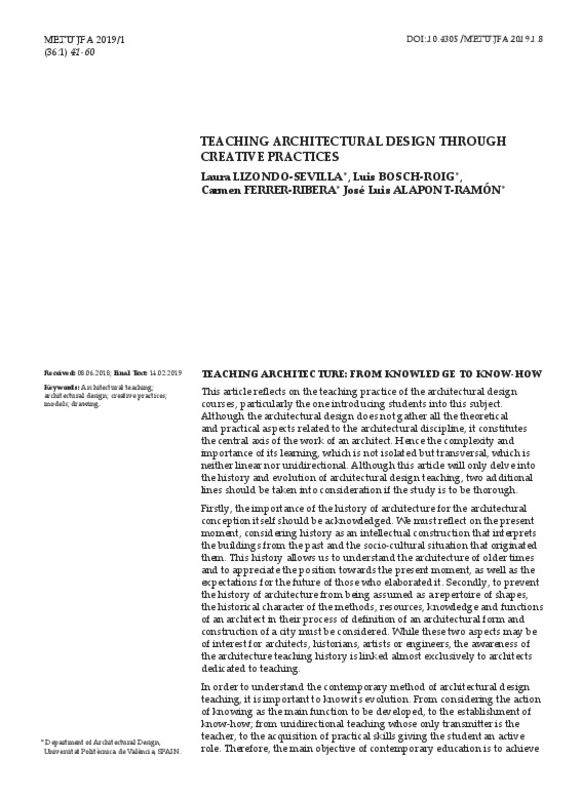|
Resumen:
|
[EN] This article provides investigation details of teaching architectural design as a fundamental part of the architectural discipline. This line of research delves into learning about the most creative action of the ...[+]
[EN] This article provides investigation details of teaching architectural design as a fundamental part of the architectural discipline. This line of research delves into learning about the most creative action of the architectural production process, design, taking into account that creativity must be complemented by disciplinary training that combines both theoretical knowledge and practical skills. Considering these observations, this text provides information about the experience accomplished by four teachers from the School of Architecture of the Universitat Politecnica de Valencia (ETSA-UPV) on the subject of Design Studio 1 for the first-year studies. The propaedeutic character of this subject shows additional difficulties given the complexity of introducing the students into the field of architectural design.
The article begins with a description of the historical background of teaching architecture, contextualizing the object of study and also the different processes used as reference during the accomplishment of the teaching experience. The second section includes a description of basic methodology of the specific case of the first-year subject taught in the ETSA-UPV. It provides analysis of its evolution, detection of the problems and suggested variations of the learning method in order to improve the final results. The canonical teaching method is based on a linear process starting with the theory, followed by architectural analysis, finishing with project synthesis, which generates important doubts for the first-year students when implementing the theory in the project phase. Therefore, resuming the cycle of circular learning studied by David Kolb, several creative practices have been introduced into the subject, where the order of the stages depends on the particular characteristics of each individual and learning takes place by combining practices of perception and comprehension.
Keeping in mind the main goal of the new teaching approach, the third part of the text includes a description of several activities. They are designed using a methodology capable to promote the transfer of knowledge between the analysis phase and the project phase. Creative practices are based on the learning by doing process, where reflection, conceptualization and experimentation are carried out with two basic tools: hand drawing and the three-dimensional model. With the practices and these two manual tools we seek a triple objective for students: to acquire a greater creative capacity, to develop spatial vision and to recognize how materiality affects the definition and perception of space. The methodology of the practices includes thinking with the hands, folding the space, inhabiting the space and building the space, and it is compared to the results obtained during the academic year 2017-2018.
Finally, these results, together with the surveys completed by the students, lead to following conclusions: introducing creative activities in the first year of architectural design has shown a substantial improvement of the work carried out by students and has allowed settling the acquired theoretical knowledge. It helps to understand it not only as concepts that can be observed and analysed in reality, but also as tools of the creative process itself. On the one hand, the construction of models supports intuitive learning, allowing the students to directly recognize the consequences of their actions during the constructive process and its implications in the final result. On the other hand, the activities developed using hand drawing techniques confirm the value of the drawn plans as a tool to define the results and verify their correctness. Experiencing architecture with the hands implicitly involves a work of reflection through which the students are able to understand that space is the actual key element of the architectural project.
[-]
|









